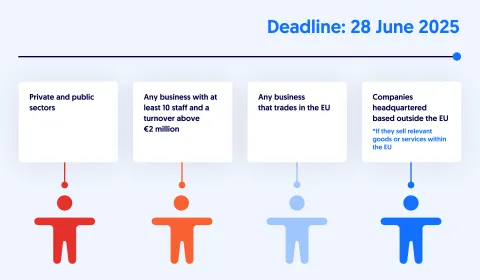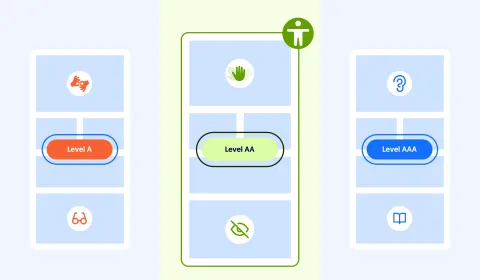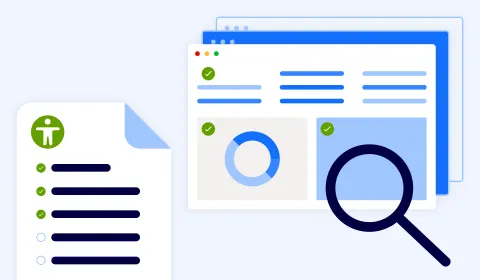Everything you need to know about The European Accessibility Act (EAA)

The European Accessibility Act (EAA) aims to enhance the accessibility of products and services for people with disabilities and the elderly throughout the EU. With less than a year remaining to meet compliance requirements, both the public and private sectors must act now. In this article, we outline your obligations under the EAA and provide guidance on how we can assist you in achieving compliance. Additionally, we offer a free accessibility audit for your Drupal website.
What is The European Accessibility Act (EAA)?
The European Accessibility Act (EAA) was introduced by The European Union (EU) in 2019 with the aim to improve the accessibility of products and services for people with disabilities and the elderly throughout the EU.
The EAA covers a wide range of products and services, including digital products (websites, mobile apps), e-commerce services, consumer banking services, electronic communication services, and certain physical products like ATMs.
The deadline for meeting the EAA is 28 June 2025. From this date, new products and services offered in the EU must be launched as conformant.
80 million people living in the EU have some kind of disability. With an ageing population this number is growing. Furthermore, many of us will experience temporary impairments during our lifetime. Compliance with EAA will ensure your products and services are open to all.

Who does it apply to?
Unlike previous legislation that targeted the public sector, the EAA expands obligations to private sector organisations selling products or services to customers living in EU member states. It applies to any business:
- with at least 10 staff and a turnover above €2 million.
- that trades in the EU.
Companies headquartered based outside the EU must comply with the EAA if they sell relevant goods or services within the EU.
How is it enforced and what are the penalties?
Businesses operating in the EU, especially those in the private sector, need to start aligning their products and services with the EAA's standards to avoid penalties. The Act includes provisions for exemptions, primarily for micro-enterprises, and for cases where compliance would impose a disproportionate burden.
Enforcement and monitoring of compliance will be undertaken by designated national authorities in each Member State. They will perform compliance checks on services, market surveillance of products and handle any non-compliance issues. Penalties will be set locally but may include:
- Fines
- Market Restrictions
- Product Withdrawals
- Administrative Sanctions
Companies not complying with the regulation may get a fine of 100.000 €.

What compliance is required?
The EAA does not itself define specific technical standards for accessibility. Rather it uses EN 301 549 as its presumptive conformity standard, which requires conformance with WCAG version 2.1 AA standards.
To comply with the EAA providers must design products, devices, services or environments to be used by people with disabilities on equal basis with others. Providers must also publish accessibility statements stating how they meet the Act’s requirements.
Businesses operating in the EU, especially those in the private sector, need to start aligning their products and services with the EAA's standards to avoid penalties.
How can I assess whether my current products and services are compliant?
In terms of Drupal websites, digital products and services we offer a full accessibility audit service. This comprehensive assessment is completed against WCAG 2.1 AA criterion, reporting violations, providing recommendations on specific actions and remedial work necessary to meet with EAA compliance.
Given the legislation comes into effect 28 June 2025 and demand for our service is high, there’s no time to delay. Take action to ensure your products and services are prepared well ahead of time.

The EAA and Drupal: How can we help you?
At 1xINTERNET we have a wealth of experience delivering WCAG compliance for both new or existing Drupal websites.
Drupal accessibility audit service
Our accessibility auditing service offers a comprehensive report that evaluates your Drupal website's compliance with The European Accessibility Act (EAA). The report outlines the necessary steps to achieve full compliance. In line with our commitment to promoting an accessible internet, we are currently offering free accessibility audits.
Accessibility tools and automatic testing
Changes to content, design enhancements, and new features on your Drupal website can impact accessibility. Therefore, maintaining compliance over time demands a continuous commitment across design, development, and content creation.
To help with this we offer editorial tools, open-source testing and reporting enabling your team to maintain compliance effectively. If you would like to hear more about how 1xINTERNET can help you, speak to our team today!
Other highlights
Web Accessibility and synergies to SEO

The purpose of web accessibility and web design is to ensure that certain groups of people, for...
Sitemaps - Why are they good for SEO?

In general, sitemaps provide an overview of the content of a website so that users and crawlers can...